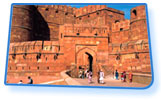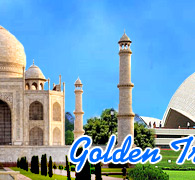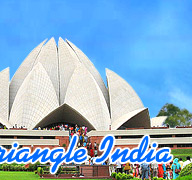
On the shores of River Yamuna, to the northwest of the Taj Mahal, Emperor Akbar started a majestic fort, which gained Jehangir and Shah Jahan as its future benefactors who added rose-red sandstone and marble buildings to it respectively. Within 2.5- km-long and 20 feet high fortified walls, the premises of the fort houses many visionary palaces, such as the Jahangir Palace and the Khas Mahal, audience halls, such as the Diwan-i-Khas; and two very beautiful mosques.
The massive gatway of Amar Singh gate towards the south is the entry point of the fort. The myriad buildings and structures inside the fort give an impression of a city within the city. The marble pearl mosque inside the fort is one of the most beautiful mosques in India, while the two gardens within the pavilions are small but well kept.
Fatehpur Sikri
40 km from Agra, the city of Fatehpur Sikri served as the capital of the Mughal Empire between 1570 and 1586. But as abruptly as it had been built, it was abandoned due to the scarcity of water. A popular legend is attached to the city's conception. According to it, Emperor Akbar was without a male heir, and was granted one by the blessings of the Sufi saint Sheikh Salim Chisti. In honor of the saint, Akbar named the prince Salim, and decided to found a new city to celebrate his birth. And thus, the magnificent Fatehpur Sikri, the new capital, came into being. The city was intended to embody the noble ideals, and the humanitarian bent of this dynamic emperor. The finest monuments within this area are the Diwan - i - Am, Diwan - i - Khas, Panch Mahal, Jama Masjid, Panch Mahal, Buland Darwaza and the tomb of Saint Sheikh Salim Chisti.
Pagal Baba Temple
Pagal Baba Temple Founded by Late Pagal Baba in Vrindavan, this gleaming white temple has eleven stories in all. One of the modern architectural examples, the temple retains the playfulness of Pagal Baba in the spirit of his disciples who are ready to welcome the visitors into the temple's interior. One can get some good views of the surrounding area from the ninth storey. The main attractions are the puppets exhibited in the temple. Some of them are mechanized and depict scenes from Ramayana and the Mahabharata.
Shri Krishna Janmbhoomi
A temple marks the birthplace of Lord Krishna today in Mathura. A narrow passage leads one into a small room with a raised platform adorned with pictures of Krishna as a child to the left. The story of His birth is written and depicted on the walls. A narrow set of marble steps leads you to the terrace and a walled corridor creates the effect of a prison. The prison and the other buildings were razed to the ground in the 17th century but were restored in 1962 by industrialists like G.D. Birla.
Ghats of Varanasi
The Ghats of Varanasi are the best place to see the charming spell of the old-world traditions and the cultural identity of the city. Stuck in a time warp, every morning, these Ghats come alive with the first rays of the sun as the sacred waters of River Ganges assumes different shades of gold and yellow and thousands of devotees take the ceremonial dip in it and offer prayers while standing waist-deep in the river waters. There are 84 bathing ghats in the city.
Lotus Temple
 Bahai faith represents the equality of mankind and oneness of its soul. The
same feeling has been successfully transcended into the beautifully and
scientifically degined Bahai Temple in Delhi, designed by Fariburz
Sahba, an Iranian-born Canadian architect, in shape of the lotus flower,
symbol of purity throughout India and predominantly celebrates the
number nine, which not only represents the highest digit but also unity
in the Bahai faith. There are nine pools that have been constructed on
the elevated platform signifying the green leaves of the lotus and also
serves to cool the stark, elegant interiors of the structure. The
delicate and sleek architecture is built in two layers. The first layer
consists of nine white marble-covered petals pointing towards heaven,
while the second layer of nine petals serves to conceal the portals.
When seen from a short distance, it looks like a fabulous example of
origami work. The interior, especially, the Hall of Worship, conforms to
that of all Bahai temples and is so silent that even a low whisper
echoes loudly in the structure. No religious icons are housed here
except the copies of the Holy Scriptures and wooden pews. The
construction of the temple was completed in 1986.
Bahai faith represents the equality of mankind and oneness of its soul. The
same feeling has been successfully transcended into the beautifully and
scientifically degined Bahai Temple in Delhi, designed by Fariburz
Sahba, an Iranian-born Canadian architect, in shape of the lotus flower,
symbol of purity throughout India and predominantly celebrates the
number nine, which not only represents the highest digit but also unity
in the Bahai faith. There are nine pools that have been constructed on
the elevated platform signifying the green leaves of the lotus and also
serves to cool the stark, elegant interiors of the structure. The
delicate and sleek architecture is built in two layers. The first layer
consists of nine white marble-covered petals pointing towards heaven,
while the second layer of nine petals serves to conceal the portals.
When seen from a short distance, it looks like a fabulous example of
origami work. The interior, especially, the Hall of Worship, conforms to
that of all Bahai temples and is so silent that even a low whisper
echoes loudly in the structure. No religious icons are housed here
except the copies of the Holy Scriptures and wooden pews. The
construction of the temple was completed in 1986.Purana Qila
From the recent excavations near this fort, archaeological evidences such as pottery have been found which throws a new light on the existence of the city of Indraprastha at this place in Delhi, as mentioned in the great epic of Mahabharata. Sher Shah Suri built the fort and completed it in 1545. However, he soon lost it to the Mughal emperor Humayun, who made good use of the octagonal red sandstone tower known as 'Sher Mandal' as his library and observatory. It is rumored that Humayun slipped from the second storey steps and met his death here. There is a dainty small lake in its premises, where one can enjoy boat rides during summers.
Sahastradhara
Sulphur springs in Dehradun have long been credited with unique healing powers for certain diseases both in the early eastern and the western medical sciences. 14 km from the centre of the city, Sahastradhara is such a place where one can see people coming from far off with their ailing loved ones in search of a natural cure. It also makes an excellent picnic spot with its lush green surroundings and foaming waterfall.
Mansa Devi Temple
A cable-car ride to the Mansa Devi Temple in Haridwar, which is situated on a hill above the city can be very thrilling, especially, when you look down from above and someone starts telling you the horror story when a cable-car was stuck in the air for hours because of a power cut. However, there is no need to worry as it had been a singular incident and precautions are now taken to avoid any such instances. Another option is to climb up the 1.5 km stretch, to the temple of Goddess Mansa, one of the varied forms of Goddess Durga said to have power to grant your wishes.
Kempty Falls
13 km from Mussoorie, Kempty Falls on the Yamunotri Road are one of the biggest attractions of the place. John Mekinan developed this beautiful place as a tourist destination after 1835 as it had a breathtaking waterfall, which falls from an altitude of 4,500 feet and then splits further into five cascades.
Neelkanth Mahadeo
Situated at an altitude of 1675 m above the sea level, on a hill above Swarg Ashram, Neelkanth Mahadev is one of the most venerated temples of Rishikesh. According to Hindu mythology, it is the place where Lord Shiva drank the venom that came out of the ocean when it was churned by the 'Devatas' and 'Daityas' in search of 'amrit' (potion for immortality) to save the world from its ill effects. With the immense power of control over his body, which came with several years of strict rituals observed by Him, Lord Shiva was able to stop it in his throat forever, which though could not harm him but manifested itself in changing the color of his throat to murky blue color, thus giving Him the name of Nilkanth (one with blue throat). 12 km from Rishikesh, it is surrounded by tranquil forests.
Hawa Mahal
Hawa Mahal of Jaipur is a multi-layered palace with a beehive structure built by Sawai Pratap Singh (grand son of Sawai Jai Singh and son of Sawai Madho Singh) in 1799 and was designed by Mr. Lal Chand. The beautiful use of red and pink sand stones outlined with delicate white borders and motifs are simply out of this world. Overlooking one of Jaipur's main streets, it was originally constructed for the women of the court so that they may pass their time by watching hustle-bustle of the bazaar without being watched by people on the streets. The entire building is shaped to resemble a crown adorning Lord Krishna's head. It offers splendid views of the city, including the many old palaces and houses. Surprisingly, there is a total lack of ornamentation in the interiors of the building and chambers are stark and plain with a mass of pillars and passages that lead to the top storey.
Salem Singh ki Haveli, Patwon ki haveli and Nathmal ki Haveli
These 'Havelis' (translated as the 'Rich Merchants' house') are the gems of the exceptional and grand architecture of Jaisalmer. Salem Singh Haveli looks as if a wild flower is blossoming at the top. Guman Chand Patwa and his five sons who dealt in brocade, gold and silver embroidery that was famous from Afghanistan to China built Patwon ki Haveli. It is said to be the most magnificent mansion in Jaisalmer. The third Haveli was built by Nathmal, who was a later day prime minister, and his brother in 1885, as a gift to the Rawal but was allowed to retain it.
Temples of Khajuraho
 Conforming
to the central Indian style of temple architecture, the temples of
Khajuraho are adorned with explicit erotic sculptures with utmost
architectural harmony and beauty. Built within a 200-year span, the
temples plan, from the simplest to the most inspiring, follow the same
pattern and all of them are ornately carved. The temples of Khajuraho
are divided into three groups - the Western group, the Eastern group,
and the Southern group. The largest and most easily accessible is the
Western group.
Conforming
to the central Indian style of temple architecture, the temples of
Khajuraho are adorned with explicit erotic sculptures with utmost
architectural harmony and beauty. Built within a 200-year span, the
temples plan, from the simplest to the most inspiring, follow the same
pattern and all of them are ornately carved. The temples of Khajuraho
are divided into three groups - the Western group, the Eastern group,
and the Southern group. The largest and most easily accessible is the
Western group.Jag Mandir
The first island palace of Lake Pichola in Udaipur, Jagmandir was constructed by Maharana Karan Singhji in 1622 AD and was intended to be a pleasure palace for imperial parties and functions. It has served as a shelter for Moghul Emperor Shahjahan when he was a prince against the wrath of his father in the seventeenth century. The tale goes on to say that Jagmandir was the inspiration behind the world-renowned Taj Mahal, which Shah Jahan built in the memory of his departed wife, Mumtaz.












